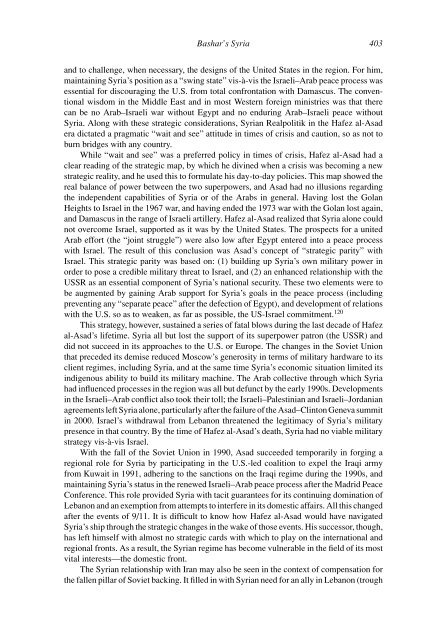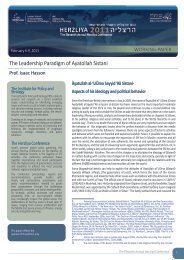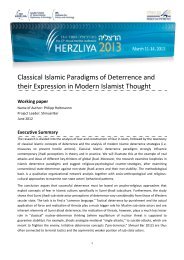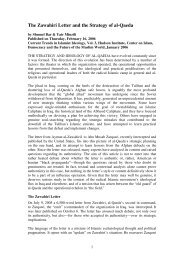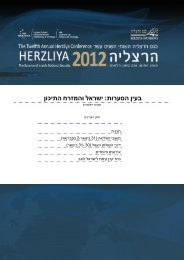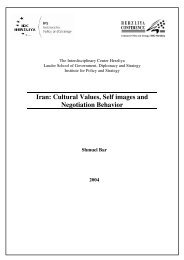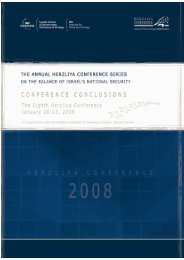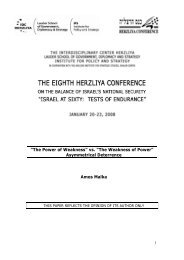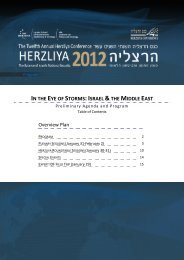Bashar's Syria: The Regime and its Strategic Worldview Shmuel Bar ...
Bashar's Syria: The Regime and its Strategic Worldview Shmuel Bar ...
Bashar's Syria: The Regime and its Strategic Worldview Shmuel Bar ...
Create successful ePaper yourself
Turn your PDF publications into a flip-book with our unique Google optimized e-Paper software.
Bashar’s <strong>Syria</strong> 403<strong>and</strong> to challenge, when necessary, the designs of the United States in the region. For him,maintaining <strong>Syria</strong>’s position as a “swing state” vis-à-vis the Israeli–Arab peace process wasessential for discouraging the U.S. from total confrontation with Damascus. <strong>The</strong> conventionalwisdom in the Middle East <strong>and</strong> in most Western foreign ministries was that therecan be no Arab–Israeli war without Egypt <strong>and</strong> no enduring Arab–Israeli peace without<strong>Syria</strong>. Along with these strategic considerations, <strong>Syria</strong>n Realpolitik in the Hafez al-Asadera dictated a pragmatic “wait <strong>and</strong> see” attitude in times of crisis <strong>and</strong> caution, so as not toburn bridges with any country.While “wait <strong>and</strong> see” was a preferred policy in times of crisis, Hafez al-Asad had aclear reading of the strategic map, by which he divined when a crisis was becoming a newstrategic reality, <strong>and</strong> he used this to formulate his day-to-day policies. This map showed thereal balance of power between the two superpowers, <strong>and</strong> Asad had no illusions regardingthe independent capabilities of <strong>Syria</strong> or of the Arabs in general. Having lost the GolanHeights to Israel in the 1967 war, <strong>and</strong> having ended the 1973 war with the Golan lost again,<strong>and</strong> Damascus in the range of Israeli artillery. Hafez al-Asad realized that <strong>Syria</strong> alone couldnot overcome Israel, supported as it was by the United States. <strong>The</strong> prospects for a unitedArab effort (the “joint struggle”) were also low after Egypt entered into a peace processwith Israel. <strong>The</strong> result of this conclusion was Asad’s concept of “strategic parity” withIsrael. This strategic parity was based on: (1) building up <strong>Syria</strong>’s own military power inorder to pose a credible military threat to Israel, <strong>and</strong> (2) an enhanced relationship with theUSSR as an essential component of <strong>Syria</strong>’s national security. <strong>The</strong>se two elements were tobe augmented by gaining Arab support for <strong>Syria</strong>’s goals in the peace process (includingpreventing any “separate peace” after the defection of Egypt), <strong>and</strong> development of relationswith the U.S. so as to weaken, as far as possible, the US-Israel commitment. 120This strategy, however, sustained a series of fatal blows during the last decade of Hafezal-Asad’s lifetime. <strong>Syria</strong> all but lost the support of <strong>its</strong> superpower patron (the USSR) <strong>and</strong>did not succeed in <strong>its</strong> approaches to the U.S. or Europe. <strong>The</strong> changes in the Soviet Unionthat preceded <strong>its</strong> demise reduced Moscow’s generosity in terms of military hardware to <strong>its</strong>client regimes, including <strong>Syria</strong>, <strong>and</strong> at the same time <strong>Syria</strong>’s economic situation limited <strong>its</strong>indigenous ability to build <strong>its</strong> military machine. <strong>The</strong> Arab collective through which <strong>Syria</strong>had influenced processes in the region was all but defunct by the early 1990s. Developmentsin the Israeli–Arab conflict also took their toll; the Israeli–Palestinian <strong>and</strong> Israeli–Jordanianagreements left <strong>Syria</strong> alone, particularly after the failure of the Asad–Clinton Geneva summitin 2000. Israel’s withdrawal from Lebanon threatened the legitimacy of <strong>Syria</strong>’s militarypresence in that country. By the time of Hafez al-Asad’s death, <strong>Syria</strong> had no viable militarystrategy vis-à-vis Israel.With the fall of the Soviet Union in 1990, Asad succeeded temporarily in forging aregional role for <strong>Syria</strong> by participating in the U.S.-led coalition to expel the Iraqi armyfrom Kuwait in 1991, adhering to the sanctions on the Iraqi regime during the 1990s, <strong>and</strong>maintaining <strong>Syria</strong>’s status in the renewed Israeli–Arab peace process after the Madrid PeaceConference. This role provided <strong>Syria</strong> with tacit guarantees for <strong>its</strong> continuing domination ofLebanon <strong>and</strong> an exemption from attempts to interfere in <strong>its</strong> domestic affairs. All this changedafter the events of 9/11. It is difficult to know how Hafez al-Asad would have navigated<strong>Syria</strong>’s ship through the strategic changes in the wake of those events. His successor, though,has left himself with almost no strategic cards with which to play on the international <strong>and</strong>regional fronts. As a result, the <strong>Syria</strong>n regime has become vulnerable in the field of <strong>its</strong> mostvital interests—the domestic front.<strong>The</strong> <strong>Syria</strong>n relationship with Iran may also be seen in the context of compensation forthe fallen pillar of Soviet backing. It filled in with <strong>Syria</strong>n need for an ally in Lebanon (trough


